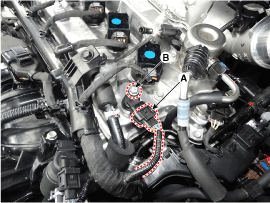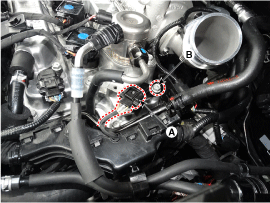Hyundai Kona: Engine Control System / Camshaft Position Sensor (CMPS) Repair procedures
| 1. |
Check the signal waveform of the CMPS and CKPS using the GDS.
|
Specification : Refer to "Wave Form"
|
|
| • |
DON’T remove the camshaft position sensor while the engine
is running or right after engine is turned off. The part and
engine oil is hot and can cause burns.
|
|
[Bank 1 / Intake]
| 1. |
Turn the ignition switch OFF and disconnect the battery negative (-)
terminal.
|
| 2. |
Disconnect the camshaft position sensor connector (A).
|
| 3. |
Remove the sensor after loosening the mounting bolt (B).

|
[Bank 1 / Exhaust]
| 1. |
Turn the ignition switch OFF and disconnect the battery negative (-)
cable.
|
| 2. |
Remove the air cleaner.
(Refer to Engine Mechanical System - "Air Cleaner")
|
| 3. |
Disconnect the camshaft position sensor connector (A).
|
| 4. |
Remove the camshaft position sensor (B) after loosening the mounting
bolt.

|
| • |
Install the component with the specified torques.
|
| • |
Note that internal damage may occur when the component is dropped.
If the component has been dropped, inspect before installing.
|
|
| • |
Apply the engine oil to the O-ring.
|
|
| • |
Insert the sensor in the installation hole and be careful not
to damage.
|
|
| • |
Be careful not to damage the sensor housing and the connector.
|
| • |
Be careful not to damage the O-ring.
|
|
| 1. |
Install in the reverse order of removal.
|
Camshaft position sensor installation bolt :
7.8 - 11.8 N.m (0.8 - 1.2 kgf.m, 5.8 - 8.7 lb-ft)
|
|
Circuit Diagram
Harness Connector
...
Description
Knocking is a phenomenon characterized by undesirable vibration and noise and
can cause engine damage. Knock Sensor (KS) is installed on the cylinder block
and senses ...
 Camshaft Position Sensor (CMPS) Schematic diagrams
Camshaft Position Sensor (CMPS) Schematic diagrams Knock Sensor (KS) Description and operation
Knock Sensor (KS) Description and operation



